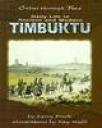Daily Life in Ancient and Modern Timbuktu, written by Larry Brook and illustrated by Ray Webb, is an informative book that gives children facts and illustrations about life in Timbuktu. The book begins with an overview of the history of Timbuktu and leads the reader through the different eras in Timbuktu’s history. The reader can learn about the roles of men, women, and children in Timbuktu. The pictures show the layout of the city, life in the desert, and people at the local markets. The maps show how Timbuktu became a great meeting place for trading goods as a result of its strategic location between trade routes and its proximity to the Niger River. Timbuktu was once a thriving city in Mali with schools, universities, hotels, mosques, and a booming trade market. Recently, the city and its people have suffered greatly as a result of war and increasingly drier conditions. The final pages show life today in Timbuktu.
Curriculum Connections
This book is a great reference for teaching students about the early West African empire of Mali (VA SOL 3.2). It shows students the importance of trade and introduces the reader to the different people groups that have populated Timbuktu throughout time. Although the book is too wordy for younger elementary students, teachers can summarize the words and show the descriptive illustrations. Each two-page spread begins with a title, so teachers can easily choose which pages are most relevant to their audiences. Older elementary students can use this book to provide information for a report on Timbuktu but may find some of the names of the leaders, people groups, and places to be a challenge to read.
Additional Resources
- For additional facts about Timbuktu, visit online the International Museum for Muslim Cultures.
- Listen to traditional Malian music played on the kora by Mamadou Diabate.
- Visit this Mali Website for lesson plan ideas.
Book: Daily Life in Ancient and Modern Timbuktu
Author: Larry Brook
Illustrator: Ray Webb
Publisher: Runestone Press
Publication Date: 1999
Pages: 64
Grade Range: 2nd-6th
ISBN: 0-8225-3215-8

